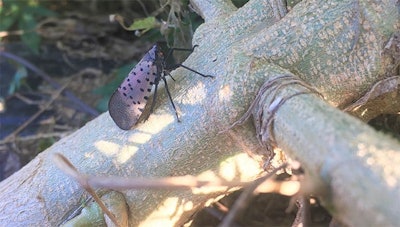
 spotted lanternfly
spotted lanternfly
The spotted lanternfly, Lycorma delicatula
As the spotted lanternfly invades the Eastern United States, feeding on plants and cultivated crops such as grapevines, Penn State University researchers have begun to look at what kind of threat these pests present to hemp crops.
Research Technologist Lauren Briggs and Extension Associate Heather Leach conducted a preliminary study, forcing spotted lanternfly nymphs to feed on potted hemp plants and scouting adult lanternflies feeding on mature hemp in the field.
“It seems like [the] spotted lanternfly has a potential to feed and survive on hemp, but right now, hemp doesn’t look like a preferred host,” Briggs tells Hemp Grower, stressing that more research is required to make conclusive statements. “We’re seeing a very low incidence in hemp fields.”
Lanternfly Invasiveness
The spotted lanternfly, known by many names—lanternfly, “SLF” or its Latin name, Lycorma delicatula, to name a few—is native to Southeast Asia and invasive in the U.S., where it has established a foothold in several states east of the Mississippi River. These pests are successful in this new habitat for multiple reasons, Briggs says, including that they feed on at least 70 different plant species. In addition, she says, “In the U.S., we don’t have the same natural predators that keep them in check in their native range.”
Those natural predators include Anastatus orientalis, a “solitary egg parasitoid” (an insect that produces parasitic larvae), and Dryinus browni, “a solitary ecto-parasitoid on nymphs,” according to the U.S. Department of Agriculture’s Agricultural Research Service. These predators are currently being researched for their ability to control the spotted lanternfly.
The spotted lanternfly has one lifecycle per year, all the while being fed on by these natural predators—and feeding on various plants.
Hatching from overwintered egg masses, the nymphs come out in the spring. “We see them on a wider range of plants that tend to be younger or more herbaceous,” Briggs says. “Then, as the season progresses and they mature, we start to see the adults much more on trees, specifically [the] Tree of Heaven. That seems to be one of their preferred host plants.”
Later in the year, spotted lanternflies sometimes disperse again from Tree of Heaven (Ailanthus altissima) to other plant species, which often tend to be woody plants, Briggs adds.
Heavy Feeders
Spotted lanternfly insects were first discovered in Berks County, Pa., in 2014, according to the Pennsylvania Department of Agriculture (PDA), and have since increasingly become a nuisance for growers of grapes, nursery crops such as rose bushes and maple trees, and others. Penn State researchers have preliminarily studied lanternfly pressure on hops, which Briggs notes is one of the most similar crops to hemp. The PDA has since set up a hotline to report SLF sightings.
They are sap-feeding planthoppers, using piercing-sucking mouthparts to feed on plants’ phloem, which transports sugars throughout the plant, Briggs says. That damage becomes difficult to assess, she adds, as the pests suck life out of plants rather than visibly chewing on them, as some others do. (Multiple pests with piercing-sucking mouthparts feed on Cannabis sativa L., including aphids, leafhoppers, mealybugs and whiteflies, J.M. McPartland wrote in a 1996 article for Journal of the International Hemp Association.)
The PDA also reports that spotted lanternflies produce a secretion, called honeydew, causing black sooty mold to develop, and damage plants.
Briggs primarily studies the spotted lanternfly in vineyards and continues to do so as she researches the insects on hemp, given viticulture’s status as a major industry in Pennsylvania. Hundreds of the insects can appear on a single grapevine at once. “Growers are reporting trouble with their vines,” she says. “Some of them are saying they’re having lower yields.”
READ MORE: Spotted Lanternfly and Hemp
Briggs and other Penn State researchers are conducting a multi-year study to try to determine at which point the pests damage grapes. They have set SLFs on the crops, then analyze vine growth, she says, as well as things like “photosynthetic rate, sap flow, shoot growth and carbohydrate content.”
“So, we’re really trying to figure out exactly what the lanternfly [does] to the plant physiologically, and then we’re also trying to figure out the more practical side of it, like at what point does a grower need to take action?” Briggs says. “How many lanternfly are dangerous to a grapevine?”
Identification Required
The PDA and other departments of agriculture in Delaware, Maryland, New Jersey, New York and Virginia have issued quarantine measures to curb the spread of the spotted lanternfly across several states east of the Mississippi. These measures are in place to prevent any material that could harbor the lanternfly from being moved, according to the Delaware Department of Agriculture. As of Jan. 5, Pennsylvania’s quarantine zones covered multiple areas around the state, including Philadelphia, Harrisburg and Pittsburgh. Other areas in the northern parts of the state, including State College, Scranton and Erie, were not under quarantine.
Under its SLF quarantine order, PDA requires businesses to obtain permits to transport various items, such as plants and mulch that could harbor insects or egg masses.
Penn State Extension has not heard from hemp growers about spotted lanternfly concerns, Briggs says. However, she says it is important for farmers to be able to identify the pest and be on the lookout. Growers can learn how to identify it by referring to the Penn State Extension lanternfly web page for information and photographs.
“If they were to see a lanternfly,” Briggs adds, “I would recommend reporting the find, especially if they are also seeing damage to their plants or it’s a new area where we don’t have the quarantine zone—that would be especially important.” Pennsylvania growers can report spotted lanternfly on Penn State Extension’s lanternfly web page or by calling 1-888-422-3359, and growers in other states can call their state department of agriculture.
Stay Tuned
Penn State researchers plan to continue this study in 2021, particularly if SLF becomes problematic or more commonly observed in hemp. Any results would likely come near the end of the year.
Patrick Williams is the senior editor for Hemp Grower, Cannabis Business Times and Cannabis Dispensary.















